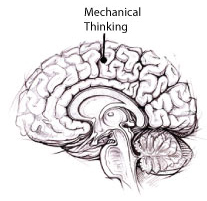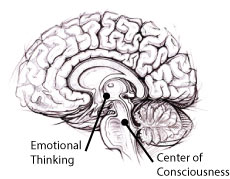In order to get students to think critically, you need to help them break through their mechanical thinking and manage their emotional thinking.
What is mechanical thinking?
When students think mechanically, their brains are just repeating looped recordings of thought without considering them. For example, students might have the mechanical thought, “I'm not good at math.” It just crops up in their brains whenever they look at a math problem. Often that little mechanical loop doesn't even relate to reality.
Why do we think mechanically?

Mechanical thinking is useful for routine tasks like walking, riding a bike, keyboarding, driving, playing an instrument, and other activities that have become part of muscle memory. To learn any of these skills takes a lot of critical thinking, problem solving, and practice, but once the skill is learned, it is stored in the motor cortex at the top of the brain. Often a person can do something with great ease but can't explain how to do it to anyone else. The skill is no longer conscious. But to learn new skills, students need to think critically, using the prefrontal cortex at the front of the brain.
How can students break through mechanical thinking?
When students are thinking mechanically about a topic in school, they are treating it like a 'muscle-memory" subroutine instead of engaging the material in a new way. Most often, mechanical thoughts manifest themselves in statements that shut down possibility. You can teach students to recognize such statements, stop them, and replace them with questions that open up possibilities:

Mechanical Thinking(statements that stop thought) |

Critical Thinking(questions that start thought) |
| “I'm not good at math.” | “How can I improve my math skills?” |
| “That's not the way Mrs. Jones taught us.” | “How many ways are there to do this?” |
| “There was only one reason for the Civil War.” | “What different factors led to the Civil War?” |
| “Current Events is boring.” | “How do events right now shape my future?” |
| “Our group never accomplishes anything.” | “Why is our group getting hung up?” |
What is emotional thinking?
When students think emotionally, they respond to an idea based on their feelings, positive or negative, rather than on critical thought: “I hate classical music.” When you challenge a student's emotional thinking, rationalizations result: “Why do you hate classical music?” “I don't know. I just don't like it. It's kind of primitive, isn't it? We've made advances in music, you know.” The student isn't really thinking critically but instead is letting thought be slave to emotion.
Why do we think emotionally?
Emotions help us respond appropriately to our environment. When we hear a dog barking viciously nearby, we feel fear, and our bodies pump adrenaline. We are ready to escape or attack. When someone we love gives us a gift, we feel gratitude, and our bodies feel completely different. We are ready to thank others and connect with them.

The limbic system, which is the center for emotion, sits atop the center of consciousness in the brain. Signals that come up from the spinal cord pass through this center of consciousness and bloom out through the limbic system before they can reach the cerebrum, where critical thinking occurs. For that reason, we think emotionally before we think critically. It's just the way the brain is designed. In order to engage objective, critical thinking, we need to manage our emotional thinking.
How can students manage emotional thinking?
Unlike mechanical thinking, emotional thinking cannot be simply stopped or replaced. Emotion is part of thought, so students can't manage it by denying it. However, you can teach students the following process for recognizing emotional thinking and consciously setting it aside in order to think critically.

Emotional Thinking(statements about feelings) |

Critical Thinking(statements setting emotion aside) |
| “I feel queasy about the lab because we have to dissect a cow's eyeball.” | “But I can set those feelings aside so that I can learn about the structure of the eye.” |
| “I love Edward from Twilight by Stephanie Meyer.” | “But for my review, I should focus on an important theme in the book instead of Edward.” |
| “I hate everything about war and wish we didn't have to learn about it.” | “But I need to learn about war to help prevent it, so I'll put my feelings aside.” |
| “Whenever the visiting fans cheer for their team, I get mad.” | “I should recognize that they want to win as much as we do, even if it is our homecoming.” |
| “I feel really nervous about our next gym unit, which is weightlifting.” | “But I can overcome my nerves because lifting weights will make me stronger.” |
Clearing the Way
Mechanical thinking is great for walking, eating, dancing, and other actions that require muscle memory. Emotional thinking is important for responding appropriately to our environment. But to think critically, students need to break through their mechanical thinking and manage their emotional thinking. By providing them the strategies above, you can help them think more deeply about any topic.